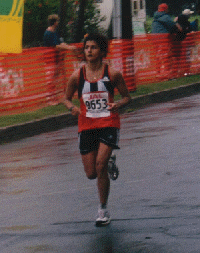Hill training can be divided into four training phases.
Phase One
-Acceleration
-Maintaining correct body position
-Stride
-Rhythm
Accelerate up the hill maintaining a working level between 80-85% of your MHR
(maximum heart rate)
Phase Two
-Cresting
Push over the crest of the hill and finish three hundred metres beyond the crest. This is
one interval.
Visualize the finish of the interval past the crest.
Phase Three
-Downhill
Start your recovery by running relaxed and easy going down the hill.
Let gravity assist you. Do not lean back, as this requires more energy, go with the flow.
Attempt to bring your heart rate down.
Phase Four
-Recovery
Upon reaching the bottom of the hill, bring yourself to full recovery by averaging 120
MHR. This depends on age.
When fully recovered, start your repeat of the interval.
The shorter the recovery period, the fitter you are in hill training.
Hints:
1. Start with no more than 4 hill repeats.
2. Warmup 10-20 minutes prior to hill work. Run easy.
Warmdown for the same period of time.
3. Maximum hill repeats should be no more than 12.
4. Allow rest days between hill training (at least two days before another
strenuous activity).
5. Try to keep your body perpendicular to the hill at all times.
The concept in hill training is simple. It is to stress the body by giving it a high
quality workout and then allowing it to recover and build strength. Hill workouts will
build lower leg strength, and improve your running form without the pounding of speed.
Before starting a hill, make sure that you are warmed up and feel relaxed ( 10-15 minutes
of easy jogging).
Form
When running up a hill, your arms are always synchronized with the movement of your
legs. If you feel your legs slowing down, pump your arms a little faster
and your legs will automatically speed up with them. This allows the focus to shift from
your legs to the forward motion of your arms. Do not attempt this too early or you may not
reach the top of the hill.
As you move up the hill look ahead at a it's crest. This will make the hill visually appear flatter
and not as tough. Shorten your stride as the steepness of the
hill increases. Concentrate on your form by keeping a short stride, head up, arms comfortably at 90 degrees
and your entire body perpendicular to the hill. The goal of the workout is to reach 85% of your target heart rate.
Begin with two to four hill repeats and then increase by one repeat each successive
week up to a maximum of one dozen. Allow yourself two days to recover. Do not do hill
workouts more than once per week.
While running down the hill, let gravity take control. Running downhill can be very efficient and energy
saving. You should not work against gravity, i.e. leaning back while running down a hill.
Keep your stride length short and low to the ground, but increase your cadence (leg turnover rate).
However, if you feel comfortable, open your stride. Downhill running builds the
quadriceps and the calf muscles.
Summary
Warmup for ten to fifteen minutes.
Begin with two to four hill repeats.
Pump with your arms.
Run erect looking ahead.
Keep body perpendicular to the ground.
Visualize a flat hill.
Run past the crest.
Allow two days for recovery.
Add one repeat each week (maximum 12).
© Women in Motion
Revised September 1.2000







